The ultimate Spanish comfort and party food, the Spanish tortilla, or tortilla de patatas, is a potato omelet or frittata that can be served as a tapa, side dish, or light meal.
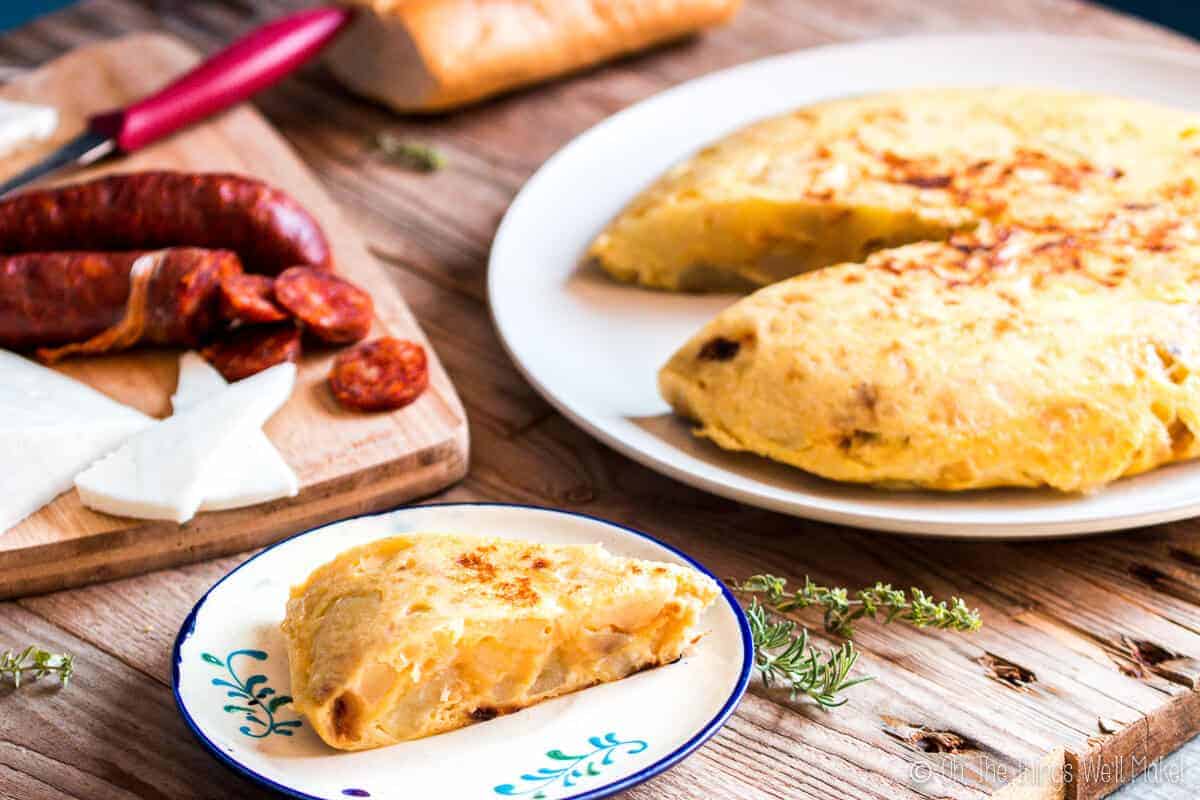
What is a Spanish Tortilla?
The word “tortilla” is understood a bit differently in Spain. In many parts of the world, one would normally first think of a wrap or flatbread of some sort. Corn and flour tortillas, for example, are used in foods like tacos, burritos, or enchiladas (or how about carnitas?). Most Spaniards, though, would first think of an “omelet” or a “frittata.” In fact, many Spaniards may not even be familiar with the other types of tortillas.
While all omelets and frittatas are called tortillas here, one stands out as being particularly “Spanish.” It’s made with eggs and potatoes and often has the addition of onions. The tortilla de patatas is very popular here, and very versatile. It can be served as a tapa, side dish, or a main dish. It’s also commonly served at parties as finger food.
The tortilla de patatas is so common here that it’s also referred to as “Spanish tortilla” or “tortilla española.”
An omelete or a frittata?
I’m not going to debate whether the Spanish tortilla is an omelet or a frittata. Some people insist that frittatas are finished in the oven, something that isn’t normally done when making a Spanish tortilla. Others insist that an omelet is folded over the ingredients, something that doesn’t fit either.
I guess if I had to choose, I’d call it a frittata. “Frittata” sounds fancier and makes me think of something on the heartier side, like the Spanish tortilla. I picture omelets as something smaller and thinner.
Let’s just say that the tortilla de patatas is an egg and potato dish normally made in a frying pan over the stove. Call it whatever you like, I guess.
How it’s served
As I said before, The Spanish tortilla is quite versatile, and shows up in a number of settings.
Here in Spain, it is common to see “tortillas” in baguette bread sandwiches (bocadillos) or on toast for breakfast or a mid-morning snack. My son usually orders “tortilla Francesa” atop his toast covered with olive oil and grated tomatoes. If you are wondering, tortilla Francesa, or French tortilla, is just the local term for omelet-style eggs.
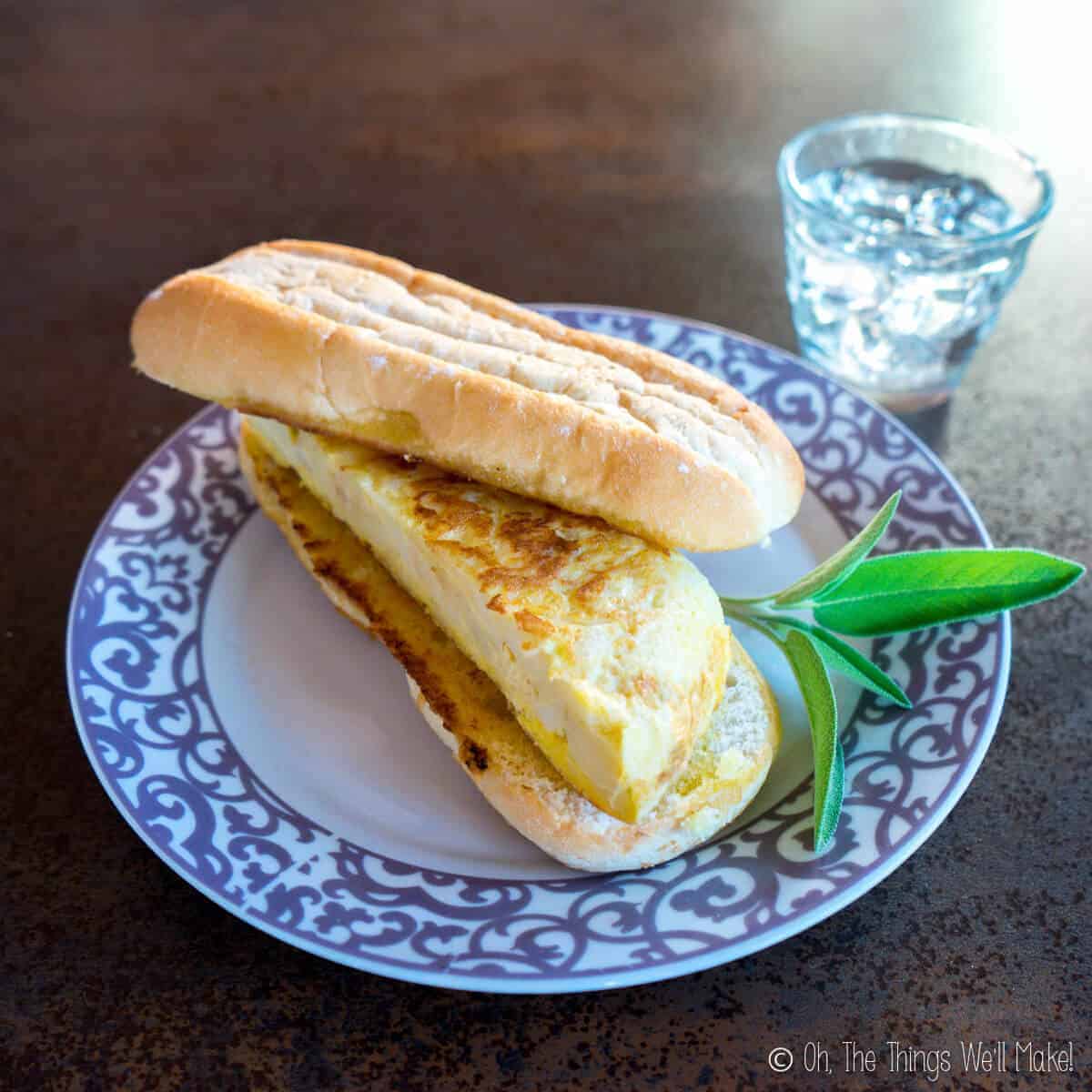
The tortilla de patatas isn’t just breakfast food, though.
It’s unusual to go to a party here without the Spanish tortilla being served as finger food. At parties, it is usually cut into cubes and served with toothpicks.
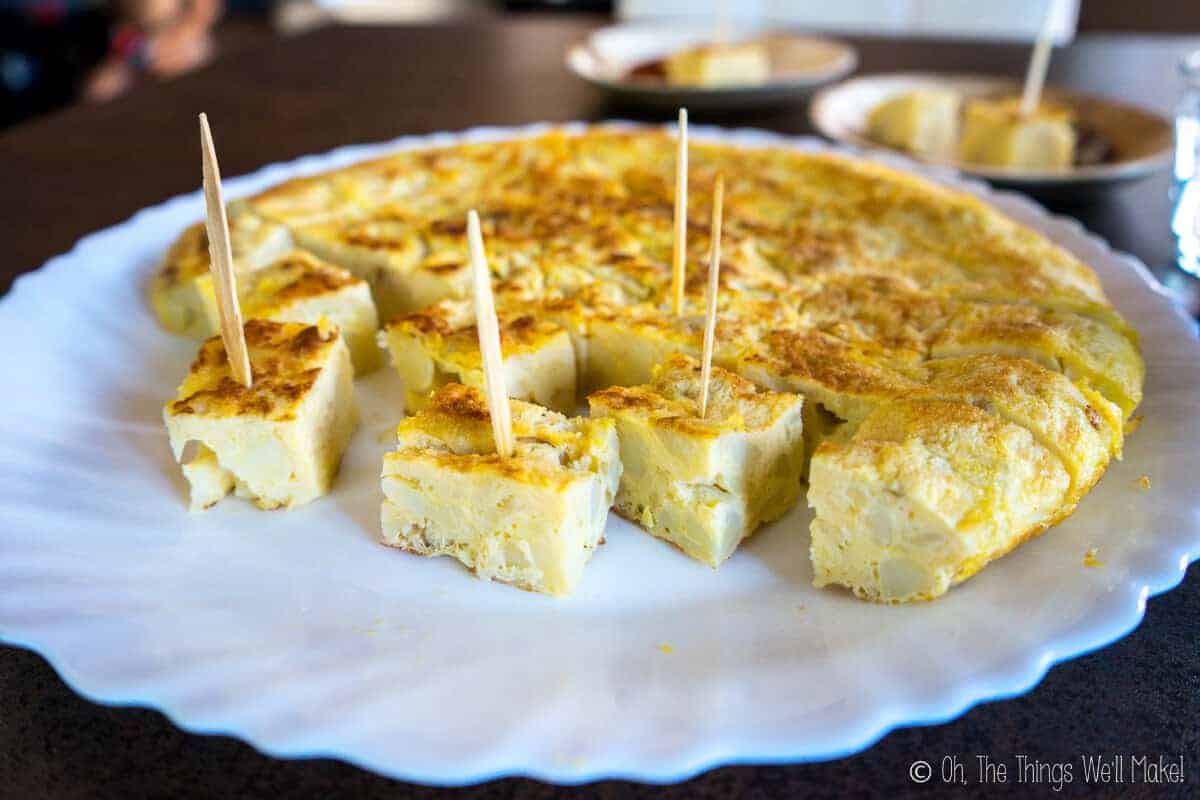
In the home and at restaurants, it’s a common dinner or side dish. Because of its circular shape, it is normally cut into wedges, like a pizza or pie.
Ingredients
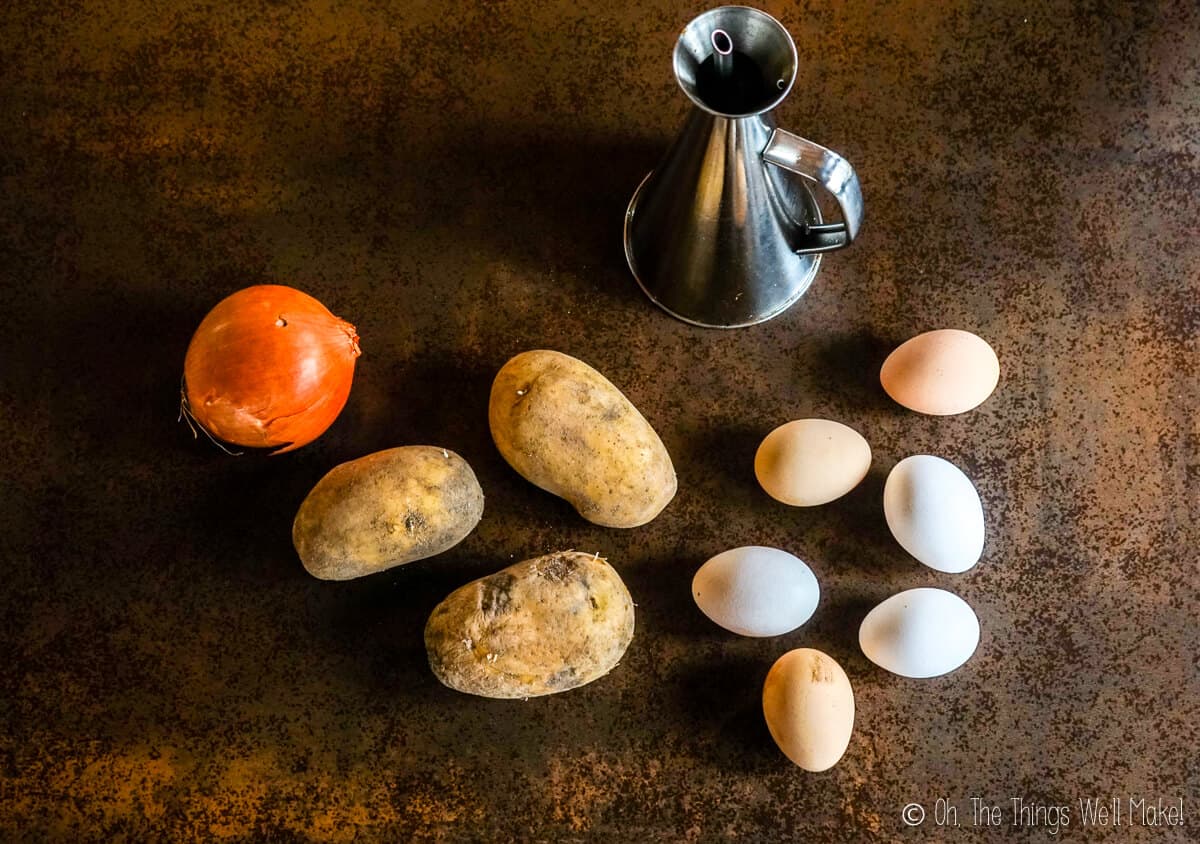
The Spanish tortilla is made with only a few, simple ingredients. Potatoes, eggs, olive oil, and salt are the main ingredients, but it is also often made with onions.
Which potatoes?
Most people here aren’t too picky about which potatoes they choose, but it can make a difference. Generally, the best potatoes for a Spanish tortilla are the same ones that work well for frying. You want potatoes that will mostly hold their shape when cooking.
I tend to choose all-purpose potatoes. They aren’t too starchy or too waxy. That said, choosing a waxy variety is probably a better choice than overly starchy potatoes that are more likely to fall apart when cooking.
While I have to admit that I often choose larger potatoes to try to save time when peeling and cutting, medium-sized potatoes are probably a better choice. They tend to be “younger” and less starchy.
The eggs
I’m lucky enough to have hens that give me fresh eggs. They roam around our garden at their own free will, much to my husband’s dismay.
I only mention it because my tortillas are often a much brighter orange-yellow color than the average tortilla. If yours doesn’t turn out as bright yellow as mine, that doesn’t mean you’ve done anything wrong. It’s probably just a difference in the eggs used.
In any case, I’d say choose the best eggs you can find. 😉
The oil
Part of the distinctive flavor of the dish comes from the oil used to fry the potatoes (and onions, if used).
While you could use vegetable oil, for authentic flavor, choose olive oil. If you’re looking for a strong olive oil flavor, choose extra virgin olive oil. My mom always made her Spanish tortillas that way.
If you prefer a more subtle olive flavor, choose a lighter olive oil. It will also cut down on the cost of the dish slightly. 😉
Should onions be added?
Whether or not the tortilla is made with onions is just a matter of personal preference. More often than not at get togethers, you’ll see one of each: a Spanish tortilla with onions and another without.
In the supermarkets, they also sell pre-made packaged Spanish tortillas either with or without onions. (Strange but true: I’ve even recently seen jars of cooked potatoes and eggs ready for cooking the tortilla at home!)
Procedure
Making a Spanish tortilla is also relatively simple.
First, you need to peel and cut the potatoes into small pieces. While that sounds simple enough, how you do it is actually a bit controversial.
Breaking or cutting the potatoes
I’ve always made the tortilla by breaking the potatoes into small pieces by sticking the knife slightly into the potato and then leveraging it to break off small pieces. That’s also how my (Spanish) husband makes it, and also how I saw a famous chef make a Spanish tortilla on tv.
On the other hand, I have seen others insist in that while you should break the potatoes for stews and dishes where you want the potatoes to release their starches, for the Spanish tortilla they should be thinly sliced.
Personally, I don’t like thinly slicing the potatoes, nor do I think it’s a common practice. Not only is it more difficult to fry thinly sliced potatoes without them breaking, the one time I tried it I didn’t like the result. One day, I made a tortilla by thinly slicing the potatoes in a food processor to save time, and it just didn’t taste the same. I never tried that way again. By the time I cleaned the food processor, I hadn’t really saved time anyway.
Chopping the onion
If you decide to add onion to your tortilla, now is the time to peel and chop the onion. I usually chop it into smaller pieces, but my husband prefers to roughly chop it into larger pieces. Again, this is a matter of preference. I like the flavor it adds, but don’t like to bite into pieces of onions as I eat.
Once you’ve chopped the onion to your liking, add it to the cut potatoes.
Most people cook the onions along with the potatoes to ensure that they soften and lose their pungency. Some people, though, even choose to begin cooking the onions before adding the potatoes. (The idea is to somewhat caramelize the onions.) Again, it’s your tortilla, so make it however you like.
If you want the onions to have a stronger flavor, cook them less time. If you want a more subtle flavor, cook them longer.
Prepare the oil
Once you have the potatoes and onions prepared, you can begin to heat the oil.
The amount of oil you use is, again, a matter of preference. It can depend, of course, on the size of pan you are using.
Even with the same size pan, though, some people prefer to submerge the potatoes and onions in a lot of oil and strain them out. Others, like my husband, prefer to use less oil and constantly carefully move the onions and potatoes so they don’t stick to the bottom.
At minimum, you’ll need enough oil to cover the bottom of the pan at least a few millimeters. Adding more will make things easier and less hands-on, but will also waste more oil. (Although you could strain the excess olive oil and use it in homemade soap.) 😉
In the end, you’ll be straining off excess oil either way, so it probably doesn’t make much of a difference in the final product.
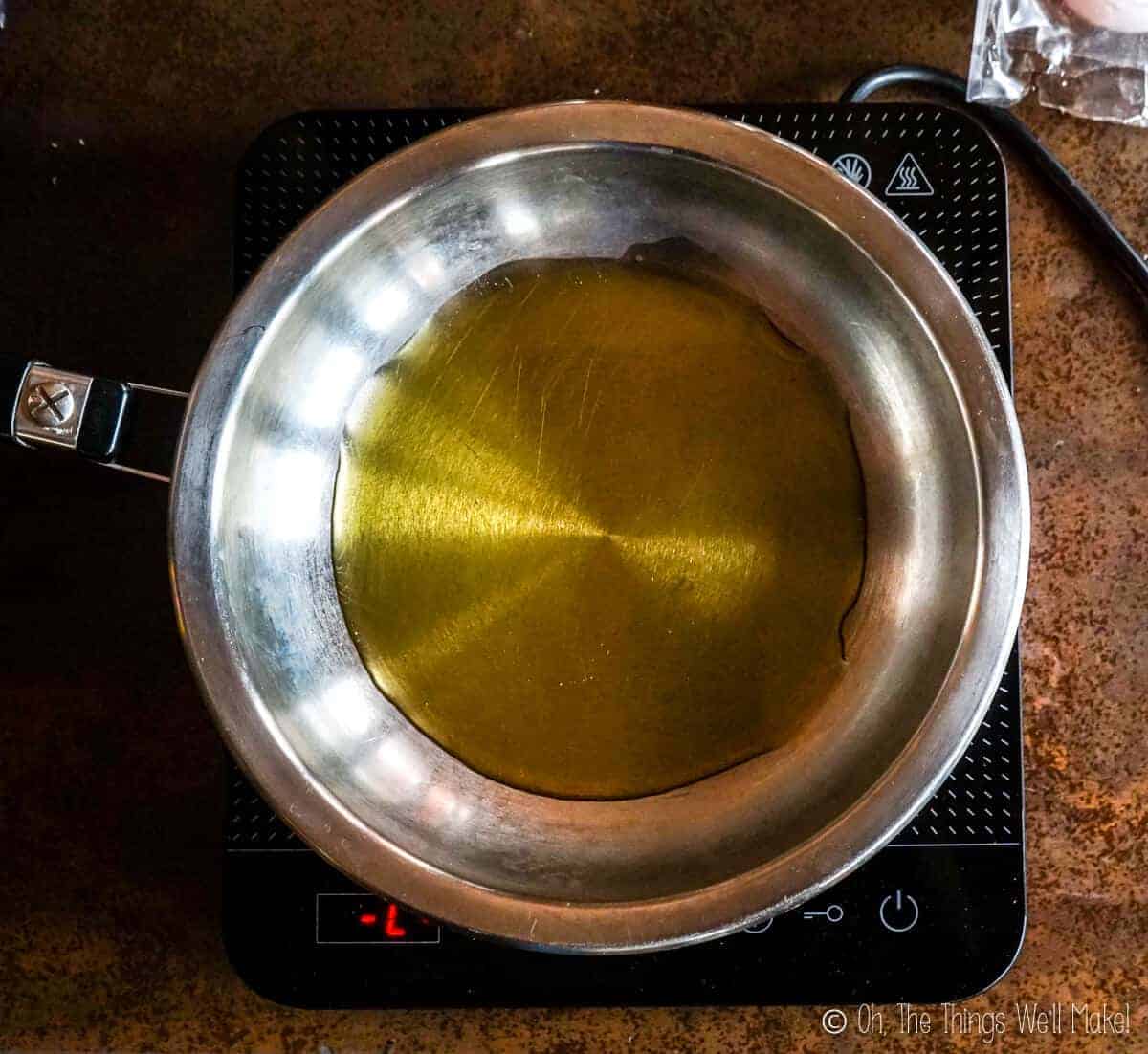
Frying the potatoes and onions
Add the potatoes and onions to the warm oil and slowly cook them until the potatoes are tender. You should be able to easily pierce them with a fork, but they shouldn’t be completely falling apart either.
Ideally, some areas will also turn a slightly golden brown, but you don’t want them crispy fried like a french fry.
Add the eggs
Once the potatoes and onions are cooked, you can strain them from the excess oil and mix them with the beaten eggs.
The number of eggs used is, once again, a matter of preference. For a drier tortilla, use less eggs (and/or don’t cook them as long). You should, at the minimum, use enough eggs to fully coat all of the potato and onion pieces. If the eggs come up to the top layer of potatoes (as seen below), that’s a good sign that you have used a good amount. (The eggs don’t need to completely cover them all, though.)
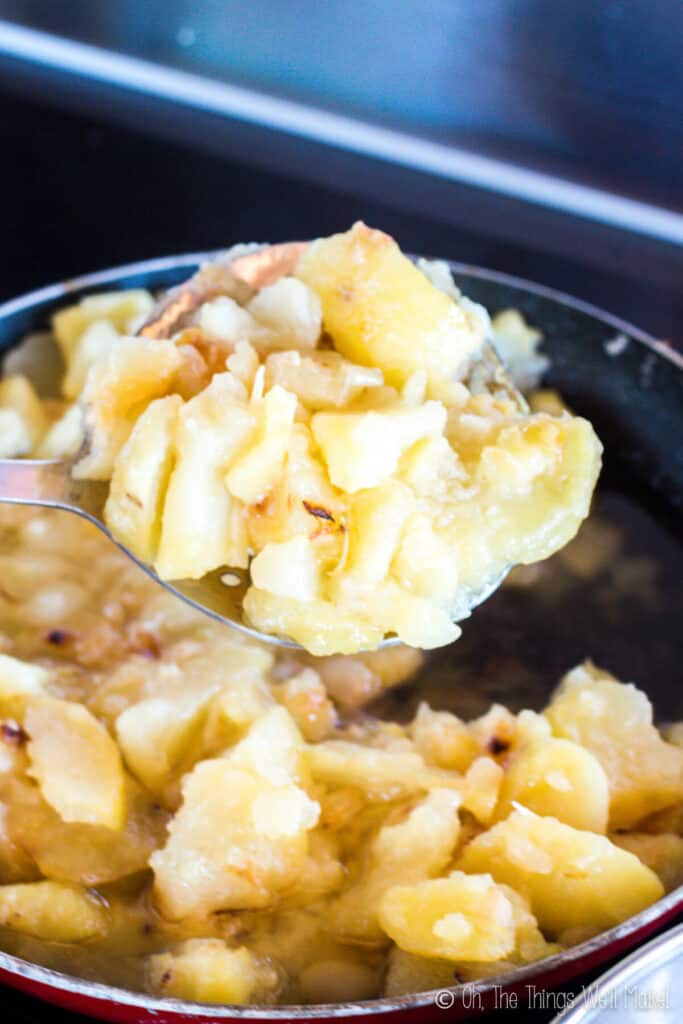
You can use a spoon with holes to strain the potatoes. 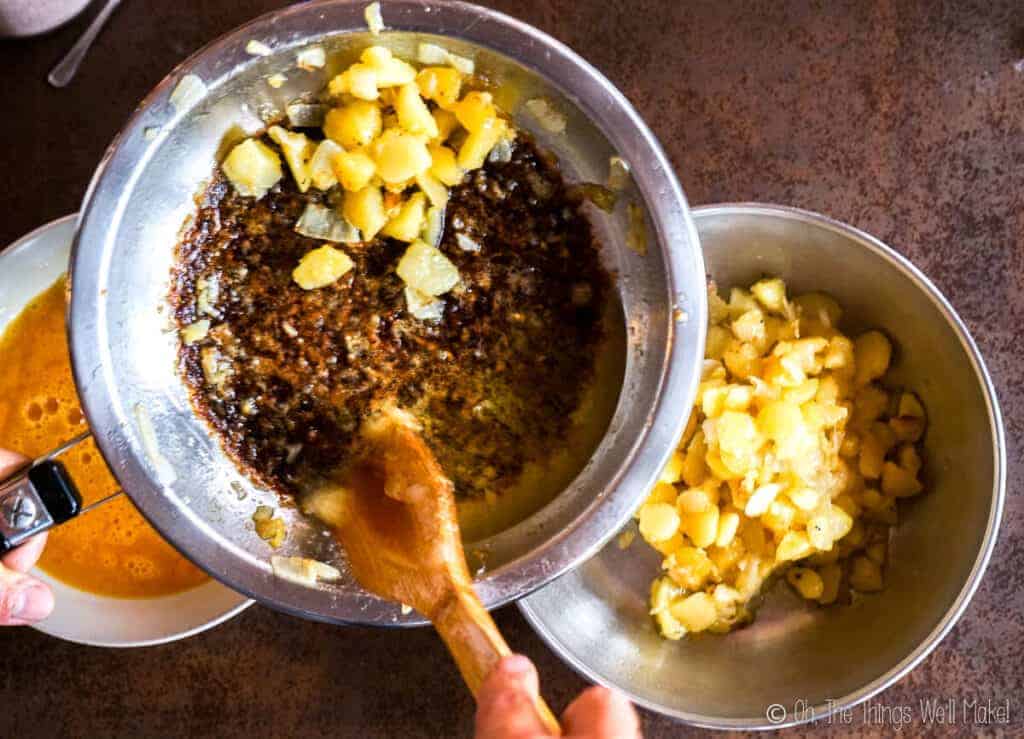
Or just use a spatula. 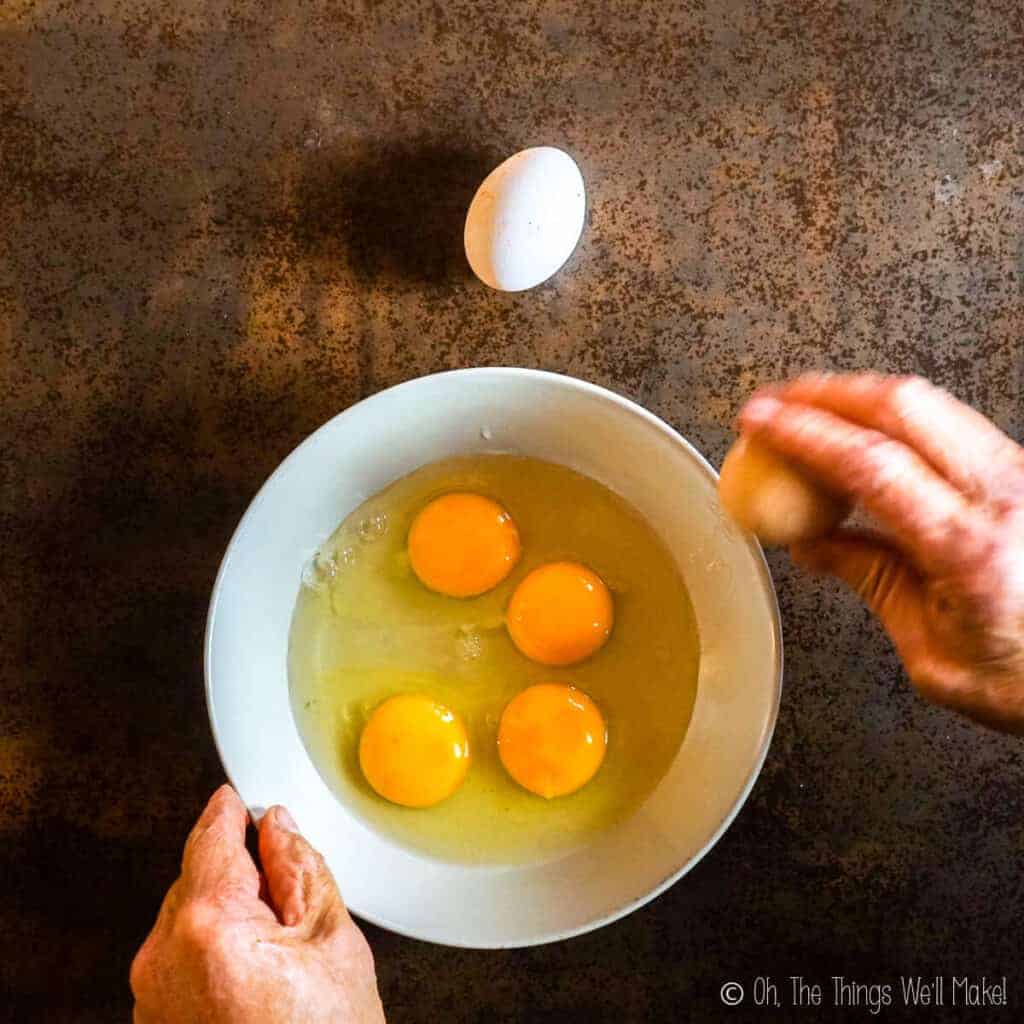
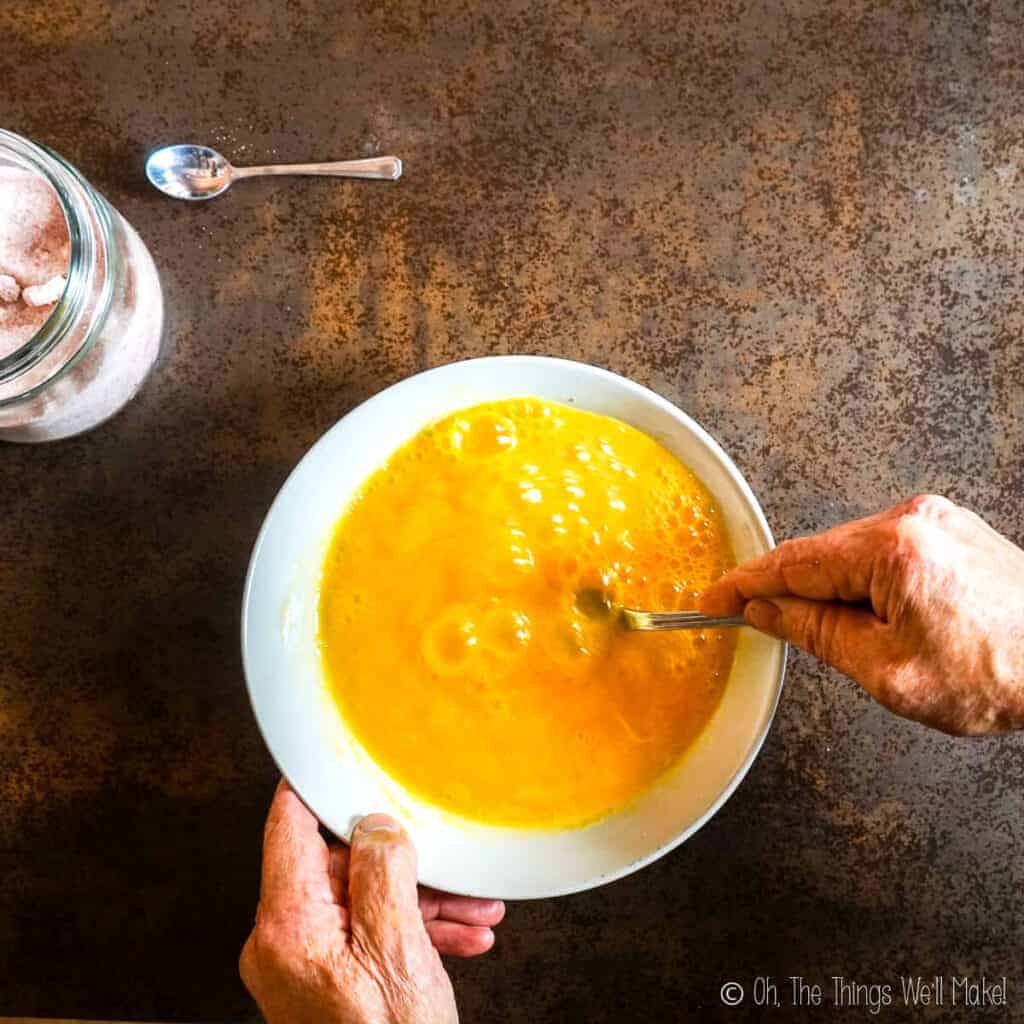
Beat the eggs well. 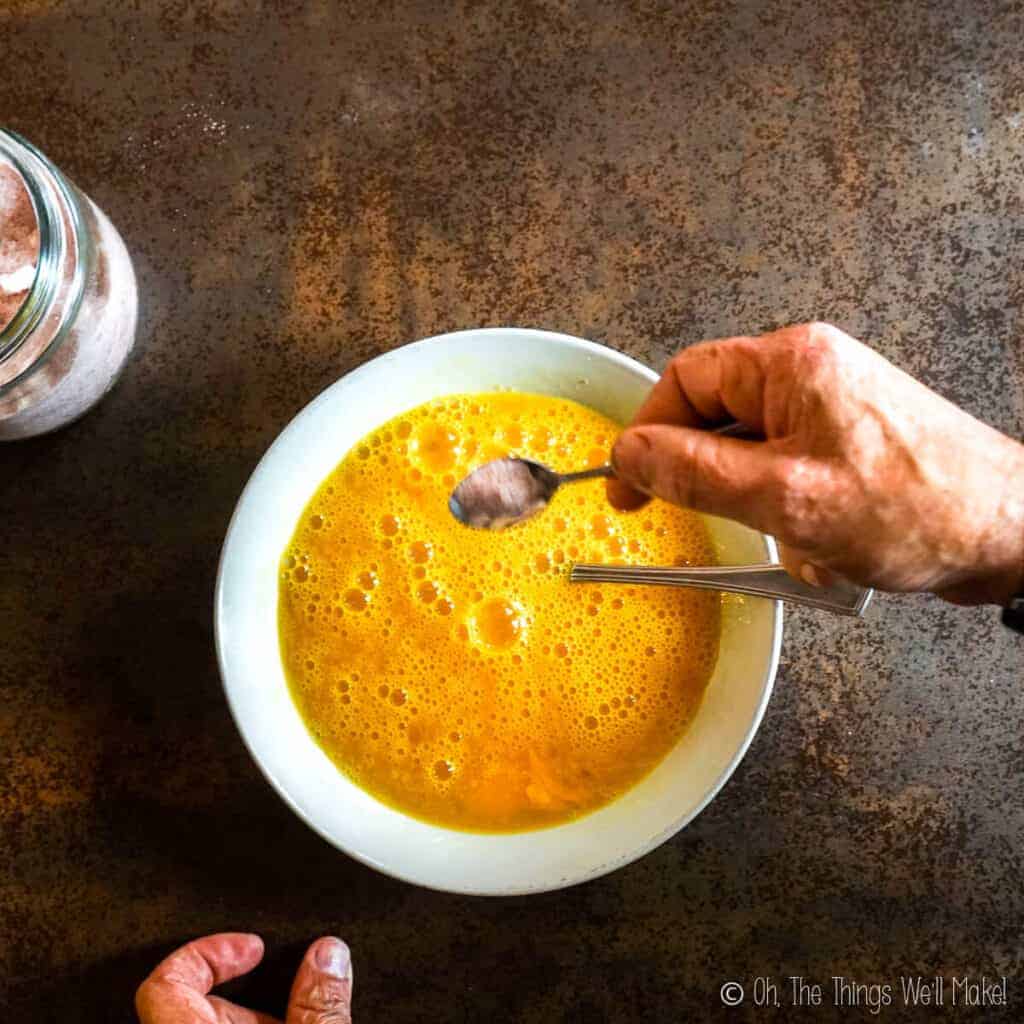
Add salt. 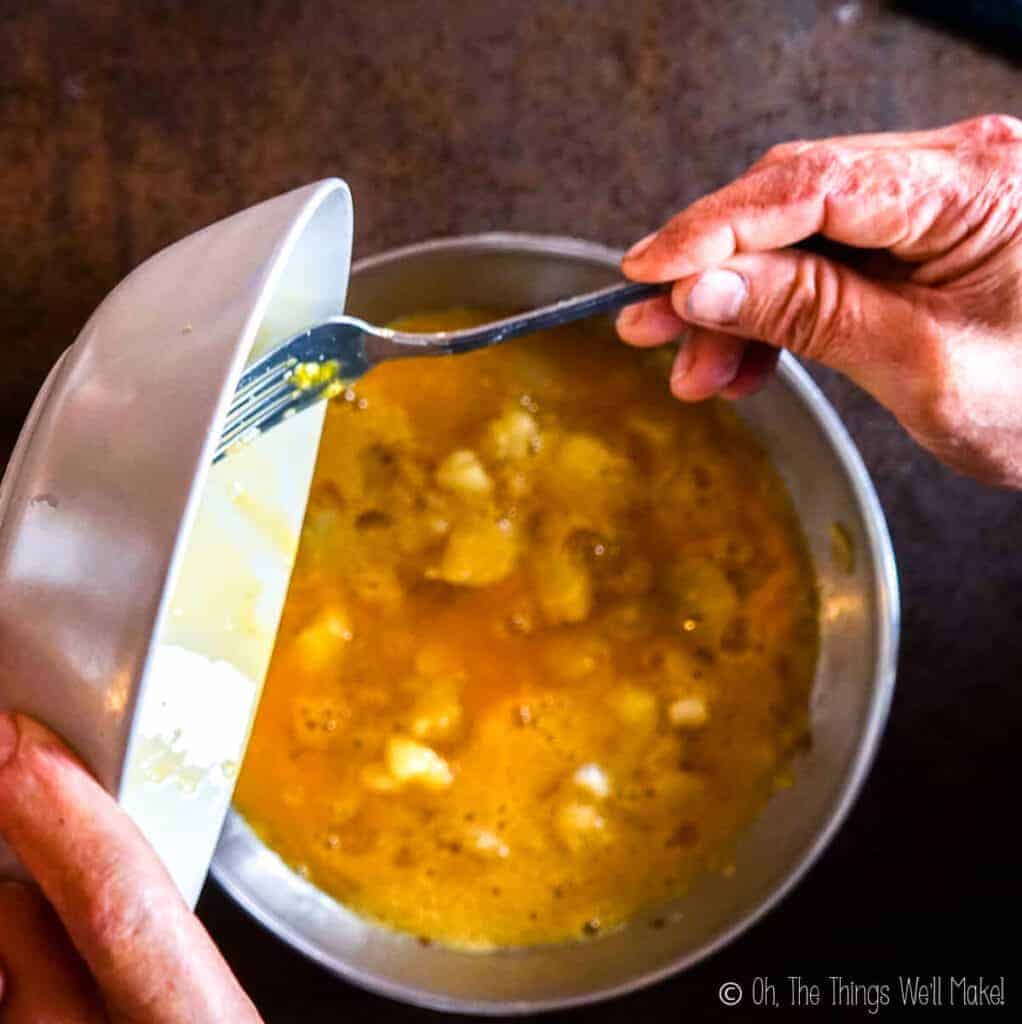
Add the eggs to the cooked potatoes. 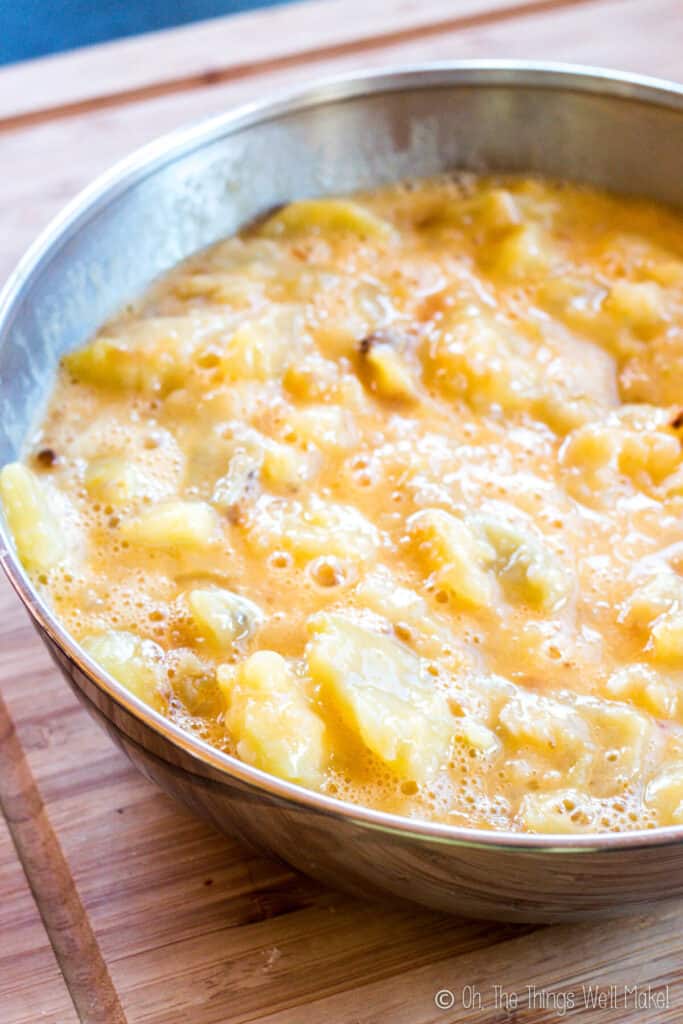
It should look like this. 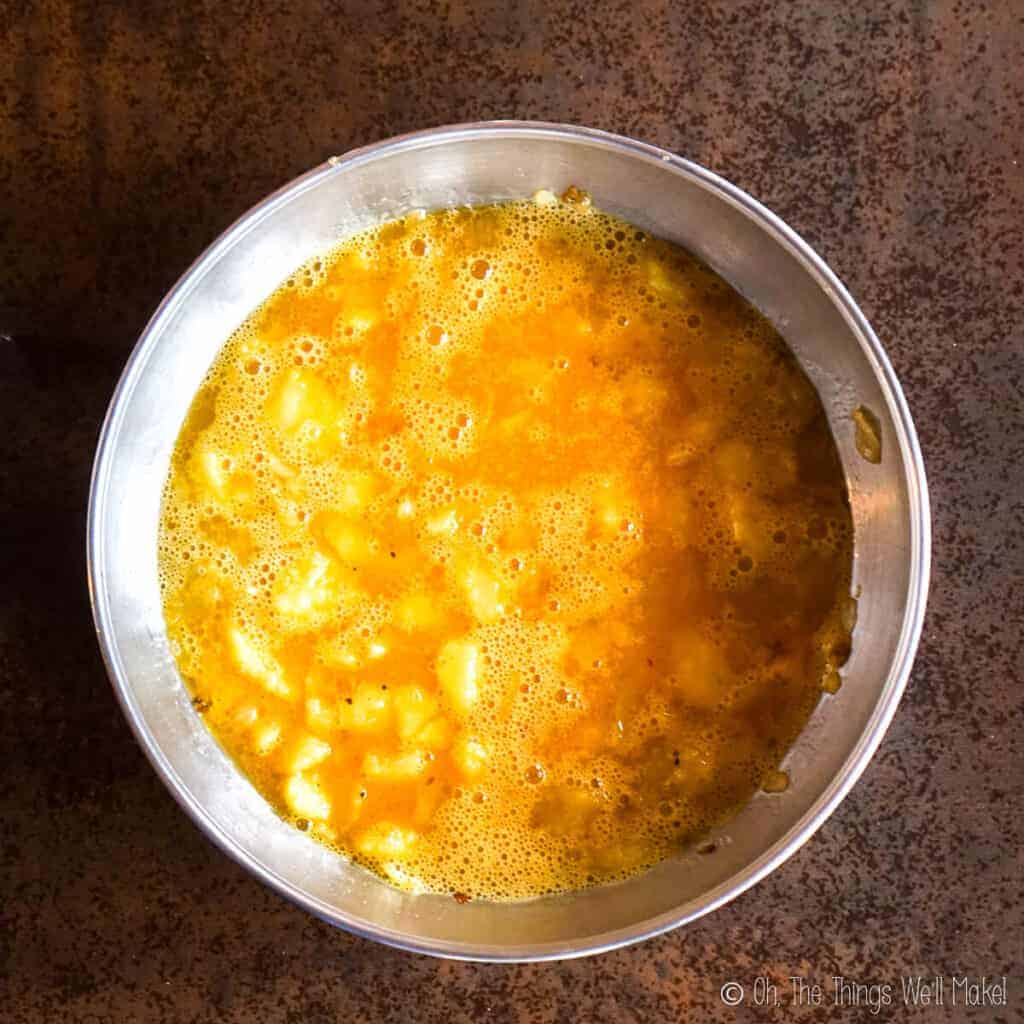
Or this.
Forming the tortilla
If you plan on using the same frying pan, make sure to fully clean it before proceeding. (Any bits of potatoes or onions that stick to the pan will cause the tortilla to stick too.)
Pre-heat the pan with a thin layer of olive oil, and then pour the egg and potato mixture into the warm pan.
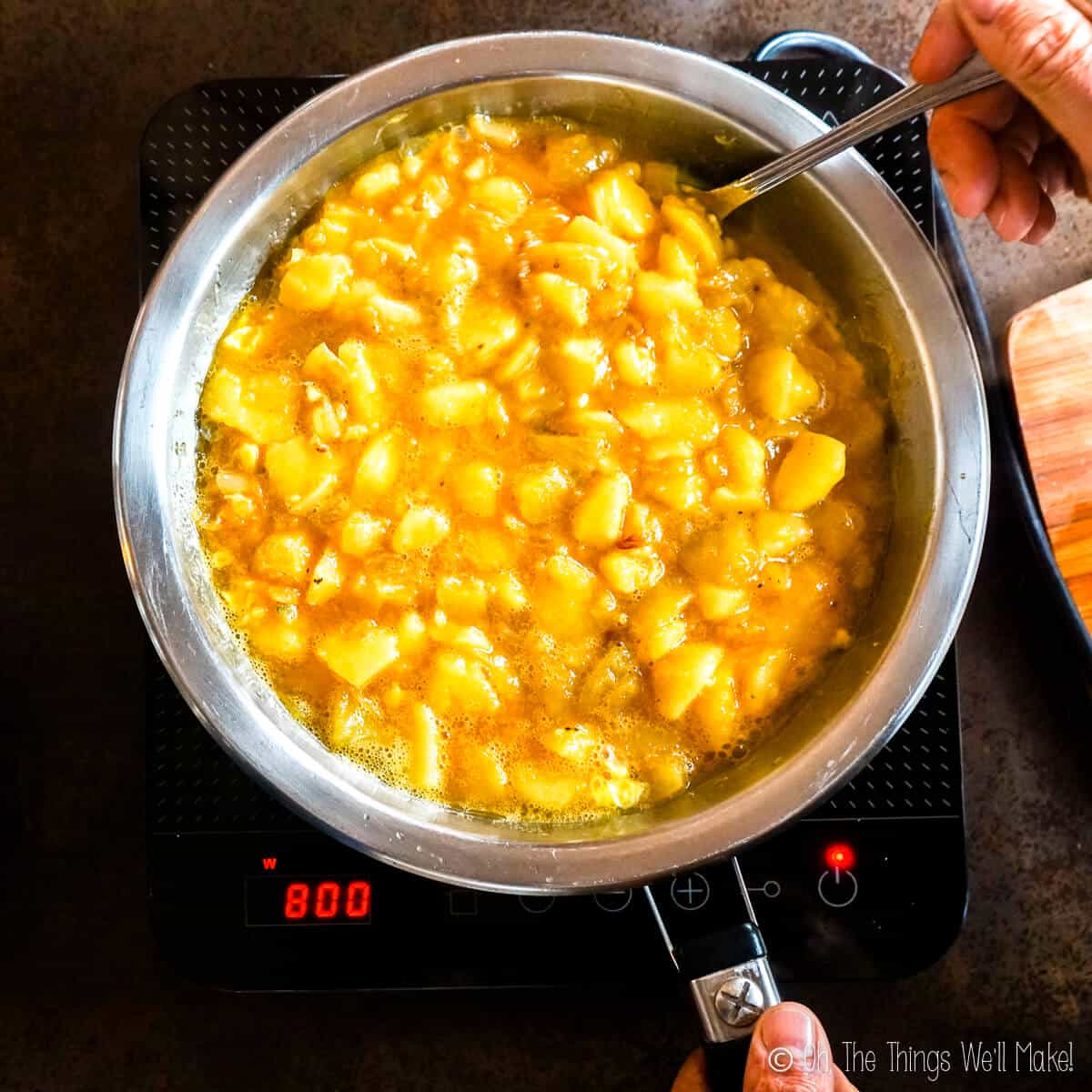
To help more fully cook the tortilla, you can stir the mixture with a fork or spatula while it begins to cook. It’s also a good idea to use the fork to lift the tortilla up around the edges. This helps prevent it from sticking and allows you to check for doneness.
Flipping the tortilla
Once the tortilla seems relatively cooked on the bottom, it’s time to flip it over to cook the other side. This is normally done by placing a large, smooth, relatively flat plate over the pan and then flipping both the pan and the plate together.
Ideally, the tortilla will filp over onto the plate. When you pull the pan away, you should end up with what looks like a cooked tortilla on a plate. The tortilla will still be raw on the bottom, though.
So, to fix that slide the tortilla back into the pan and cook the bottom half. (Again, clean it well before sliding the tortilla back in to prevent sticking.)
Once it’s cooked on the bottom, you can once again put a clean plate over the top of the pan. Flip the finished tortilla onto the serving plate!
Serving
The Spanish tortilla can be served warm immediately, but it can also be made ahead and served later. You can serve it warm, cold, or at room temperature. When stored in the fridge, you should be able to keep it for several days. That is, of course, if you haven’t eaten it first!
As I mentioned earlier, most people slice it like a pie or a pizza. At parties, though, it’s very common to cut it into small squares and serve it with toothpicks. That makes it the perfect finger food for a buffet-style service.
Variations
The most common variations are the traditional tortilla with or without onions. That said, some people like to add their own special touch to their tortillas.
Different herbs and spices
My husband, for example, likes to add a bit of freshly ground black pepper to his tortillas. Some people add paprika or smoked paprika. Others add garlic or other herbs and spices they like.
Adding veggies
While it’s not common to add vegetables other than onions, some people like to add other veggies to their tortillas. I’ve seen roasted red peppers added. I’ve also seen tortillas with added zucchini or spinach.
Adding meat, cheese, or fish
Even less common is the addition of meat, cheese or fish. That said, I’ve seen tortillas with the addition of chorizo. (Would this be a good use for your homemade chorizo?) I’ve also seen people add tuna fish, salted cod, or even hake. Adding cheese while cooking is another option.
Stuffed tortillas
Some people like to get creative and slice their tortilla like a hamburger bun and fill it as if it were a sandwich. The sky is the limit for the varieties of stuffed tortillas you can make! 😉
Light and fluffy tortillas
Fluffier tortillas can be made by whipping more air than usual into the egg mixture. Some people go so far as to whip the egg whites. Others add milk. To be honest, neither of those variations appeals to me.
The potato chip tortilla
Yes, you read that right! To save time, a Spanish tortilla can be made using potato chips instead of potatoes.
You may think that this recipe was the idea of a drunken student or one who was up all night studying for exams. In actuality, the idea came from the renowned Spanish chef Ferran Adrià. You can watch it being made on his YouTube channel.
While I almost always prefer making things from scratch, I have to admit that my curiosity got the best of me. So, I did try it. Once. For me, it was overly salty and I didn’t like the texture. Back to the traditional, from scratch tortillas for me. 😉
Expert tips
Trying to write a recipe for an authentic Spanish tortilla recipe is a bit tricky. First of all, everybody has their own method for making a tortilla. What makes things even harder, though, is that nobody I know weighs or measures out anything as they make it. It is made visually as you go.
The number of potatoes and eggs is normally decided as it is being made. The amount of oil can depend on the size of the pan you are using. The ratio of one ingredient to another is also a matter of taste. Some people prefer more eggs, other people prefer less.
My goal has been to show you the general technique for making your own Spanish tortilla. You can tweak it, with these tips, to make a tortilla that suits your taste and needs.
Runny vs. well-cooked
Some people prefer a well cooked tortilla, but others like the eggs slightly runny in the center. My husband finds a thoroughly cooked tortilla to be too dry. On the other hand, he doesn’t like it especially runny either. He does like a small amount of the slightly uncooked egg in the center of the tortilla.
I, on the other hand, prefer a thoroughly cooked tortilla. Perhaps you can see the difference between the tortilla my husband made on the left vs. the one that I made on the right.
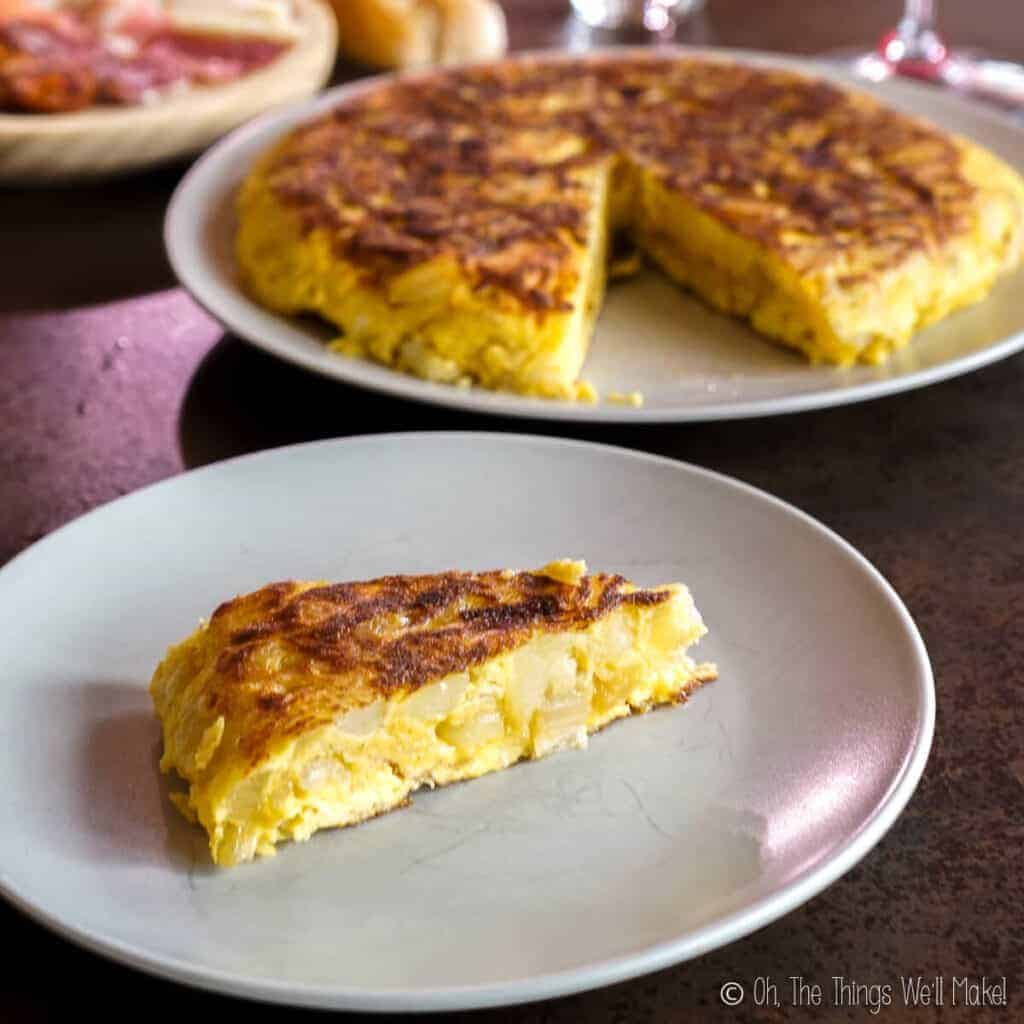
My husband prefers a less-cooked tortilla. 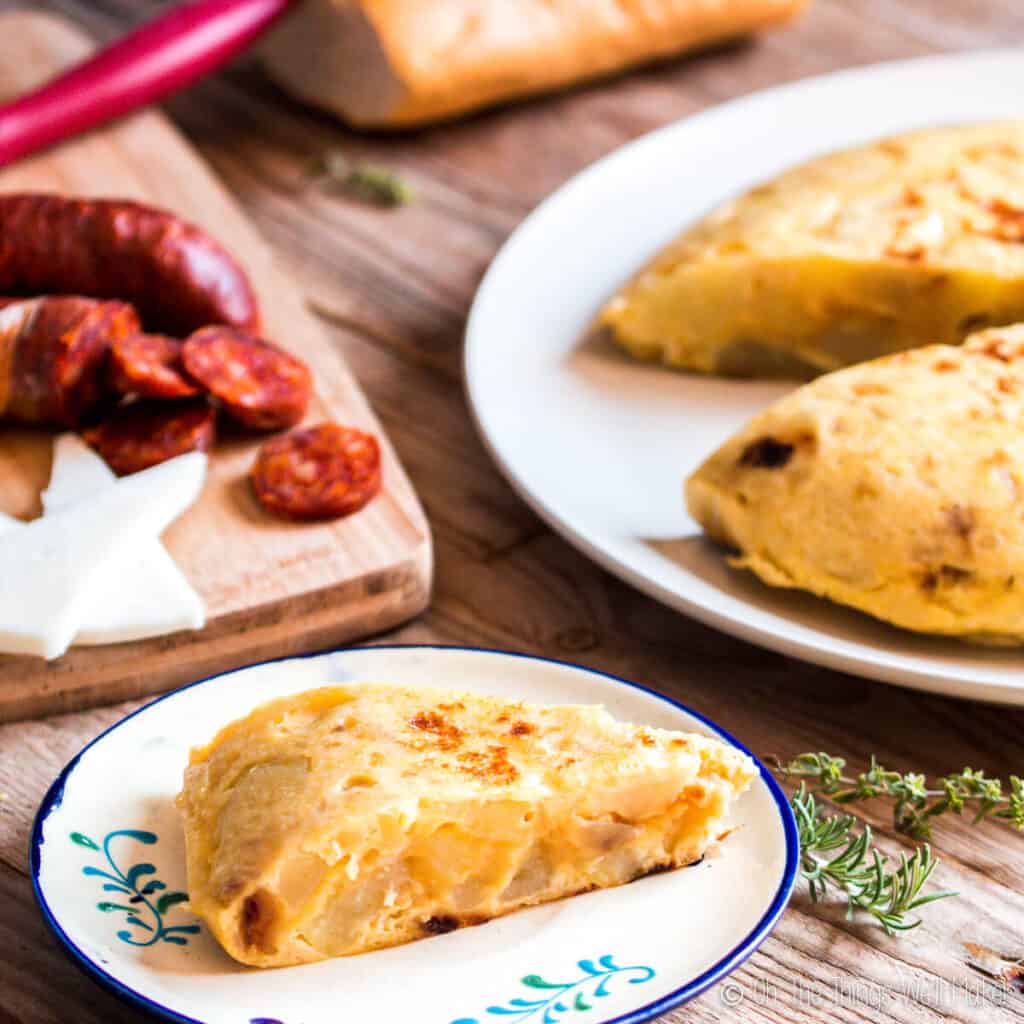
If you are looking to fully cook the tortilla, there are a few ways to do it. First, you’ll want to keep the temperature lower to avoid burning it while cooking it longer.
While it begins cooking, you can carefully stir the egg and potato mixture with a fork or spatula. That helps exchange the more raw areas in the center and the more cooked areas below.
Some people choose to cover the tortilla while it cooks to help keep the heat in and better fully cook the interior.
If you use a pan that is oven safe, you can also finish cooking the tortilla in the oven.
Preventing sticking
Most people use non-stick frying pans for making Spanish tortillas. It is said that reserving a certain non-stick pan for only eggs and other tortillas is one way to keep those pans from sticking. As the non-stick lining starts to break down, food starts to stick in the damaged areas.
For health concerns, we haven’t used non-stick pans in years. We have a couple stainless steel frying pans and some pressed iron pans that I also use. Either type of pan can successfully be used for making tortillas.
To keep the tortilla from sticking to these pans, it’s important to make sure that they are completely clean before adding the eggs each time. They should also be pre-warmed and coated with a thin layer of oil before adding the egg mixture. If you add the ingredients too quickly, while the pan is still cool or lukewarm, they are more likely to stick to the pan.
Periodically lifting up the edges all the way around the tortilla while it cooks is another way to help ensure the tortilla doesn’t stick.
Video

Authentic Spanish Tortilla Recipe
Ingredients
- 3 large potatoes (or 4-6 smaller potatoes)
- 6 eggs (more or less, as needed/wanted)
- 1 onion optional
- ¾ cup olive oil or more, for frying
- 1 Tablespoon salt more or less, to taste
Instructions
- Peel and wash your potatoes and break them into small, somewhat evenly sized pieces.
- If you decide to use an onion in your tortilla, peel and chop it.
- Add the olive oil to the frying pan and heat on medium heat. Some people add enough to cover the potatoes. Others use less, and stir the potatoes more often to ensure they are fully cooked. When it has warmed up, add the potatoes (and onions) and fry at medium heat, stirring them to keep them from burning and sticking to the bottom of the pan.
- Keep cooking and stirring until the potatoes are tender. You should be able to easily pierce them with a fork, but they shouldn't easily fall apart.
- Drain the potatoes and onions from the oil. You can use a slotted spoon or a colander to help drain them, or just carefully remove them from the oil with a spatula at an angle.
- In a medium to large sized bowl, beat the eggs with the salt. Then add the drained potatoes and onions, gently stirring the mixture to fully cover all of the potatoes. You should have enough eggs to be able to coat all of the potatoes and onions and reach the top layer of them in the bowl. The potatoes shouldn't be drowning in the eggs, though. Add another egg if you feel it's needed.
- Lightly grease a clean frying pan and warm it over medium heat. (Choose a pan that would hold all of the mixture to a height of an inch to an inch and a half. Ours was about 25cm/10inches in diameter.) When the pan is warm, add in the potato, onion, and egg mixture cook it over medium heat. Lift up the mixture around the edges to check for doneness. To help fully cook the tortilla, you can stir it gently while it first begins to cook in the pan. Then leave it alone to fully form a cooked layer.
- When the eggs start to set, especially at the edges, lift up the edges to make sure that the tortilla isn't stuck to the pan. You can separate the tortilla from the pan by running a fork or spatula around the edges. Move the pan in a brisk, circular motion to check to see if the tortilla has been released from the pan. You are now ready to flip the tortilla.
- To flip the tortilla, take a smooth, flat plate that is bigger than the size of your frying pan and place it upside down over the top of the pan. Firmly hold the plate over the pan as you carefully flip the pan over allowing the tortilla to fall onto the plate.
- Clean the pan, if any bits have stuck to it. Then, coat it with oil and heat it again. When warm, carefully slide the tortilla into the pan, leaving the uncooked side down in the bottom of the pan.
- Cook for a little while later, long enough to finish cooking through to the center of the tortilla. When you are satisfied with the level of doneness, flip it over again, this time onto a serving plate.
- Cut the tortilla and serve it! Enjoy!
Notes
Serving
The Spanish tortilla can be served warm immediately or made ahead and served later. You can serve it warm, cold, or at room temperature.
Most people slice it like a pie or a pizza. At parties, though, it’s very common to cut it into small squares and serve it with toothpicks. That makes it the perfect finger food for a buffet-style service.
Which potatoes?
Generally, the best potatoes for a Spanish tortilla are the same ones that work well for frying. You want potatoes that will mostly hold their shape when cooking. I tend to choose all-purpose potatoes. They aren’t too starchy or too waxy. That said, choosing a waxy variety is probably a better choice than overly starchy potatoes that are more likely to fall apart when cooking. While I have to admit that I often choose larger potatoes to try to save time when peeling and cutting, medium-sized potatoes are probably a better choice. They tend to be “younger” and less starchy.The oil
If you’re looking for a strong olive oil flavor, choose extra virgin olive oil. If you prefer a more subtle olive flavor, choose a lighter olive oil. It will also cut down on the cost of the dish slightly. 😉Runny vs. well-cooked
If you are looking to fully cook the tortilla, there are a few ways to do it. First, you’ll want to keep the temperature lower to avoid burning it while cooking it longer. While it begins cooking, you can carefully stir the egg and potato mixture with a fork or spatula. That helps exchange the more raw areas in the center and the more cooked areas below. Some people choose to cover the tortilla while it cooks to help keep the heat in and better fully cook the interior. If you use a pan that is oven safe, you can also finish cooking the tortilla in the oven.Preventing sticking
To keep the tortilla from sticking, it’s important to make sure that the pan is completely clean before adding the eggs mixture. The pan should also be pre-warmed and coated with a thin layer of oil before adding the egg mixture. If you add the ingredients too quickly, while the pan is still cool or lukewarm, they are more likely to stick to the pan. Periodically lifting up the edges all the way around the tortilla while it cooks is another way to help ensure the tortilla doesn’t stick.This post was originally published on July 6, 2015. It was rewritten and republished in January of 2021, adding new photos, tips, variations, and clearer instructions. Video was also added.
 Español
Español
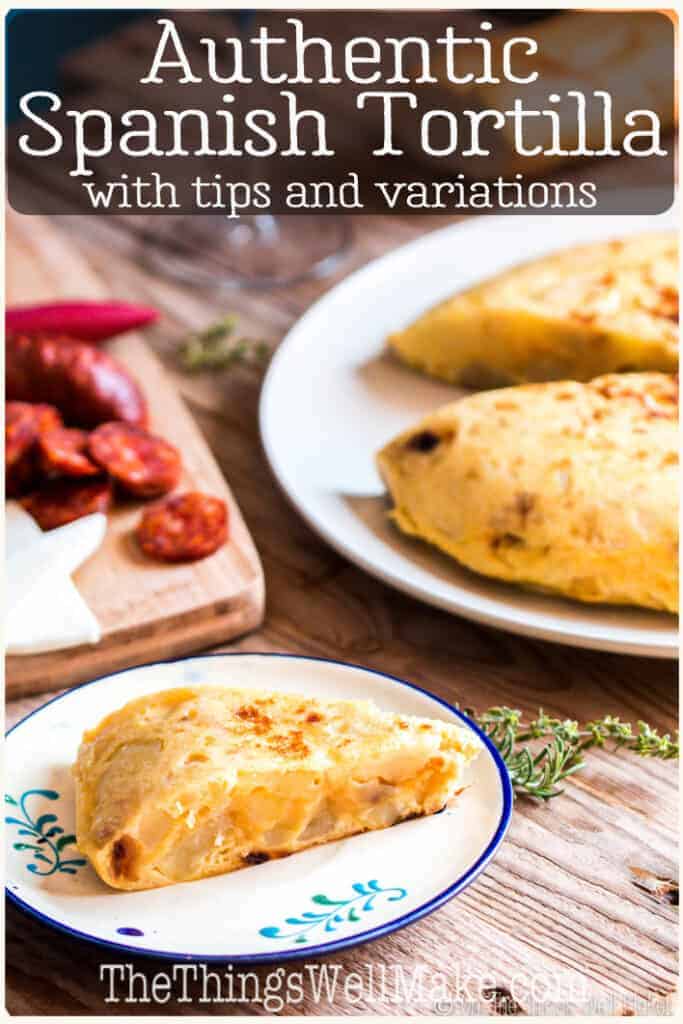
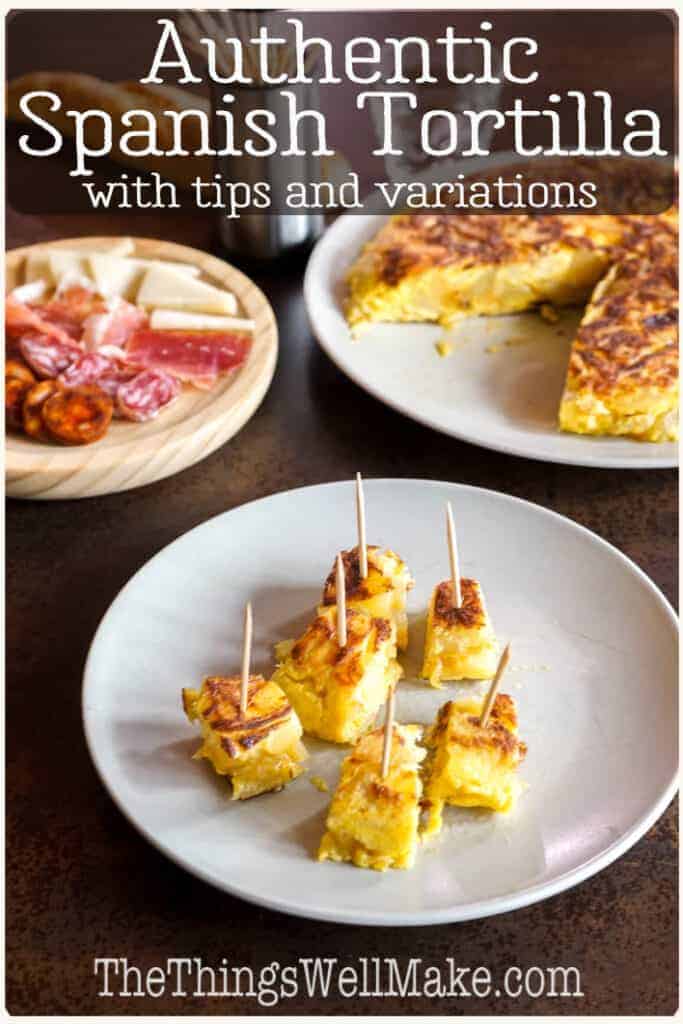
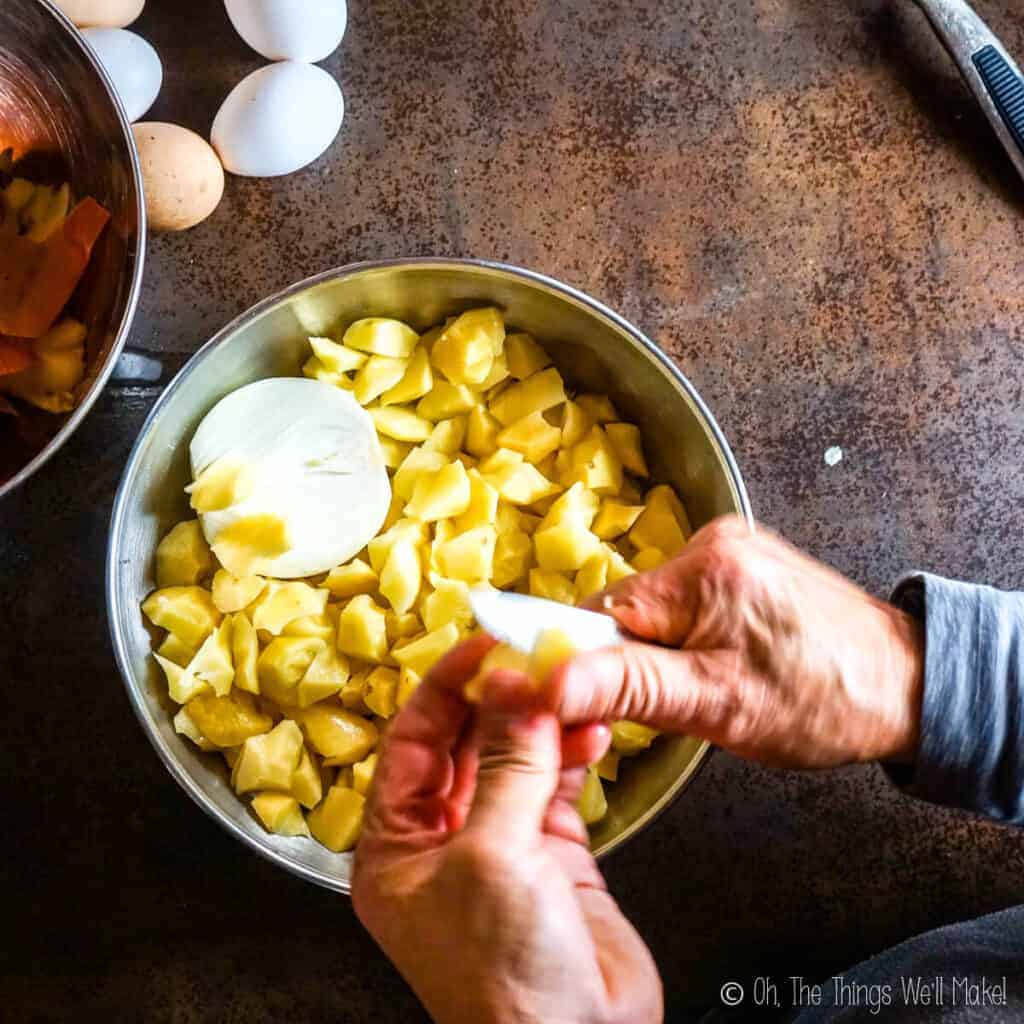
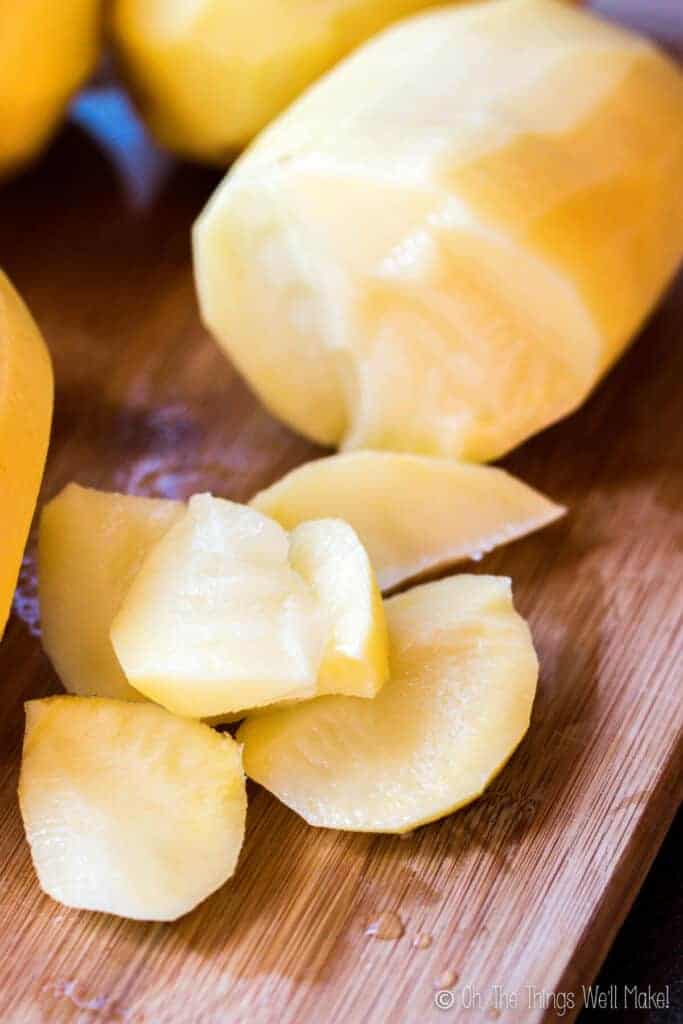
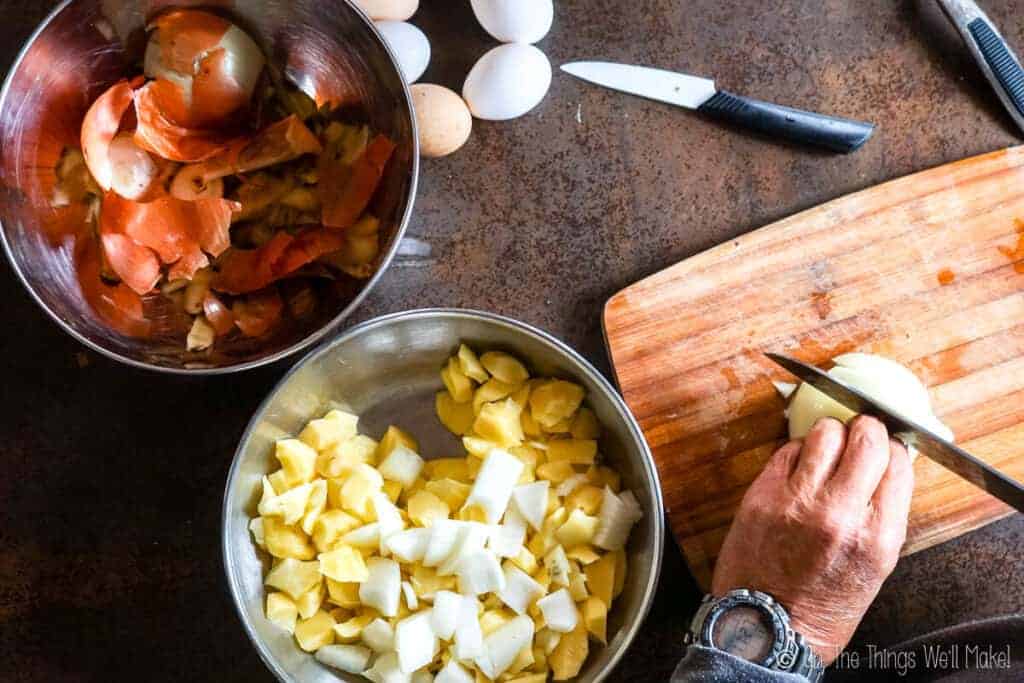
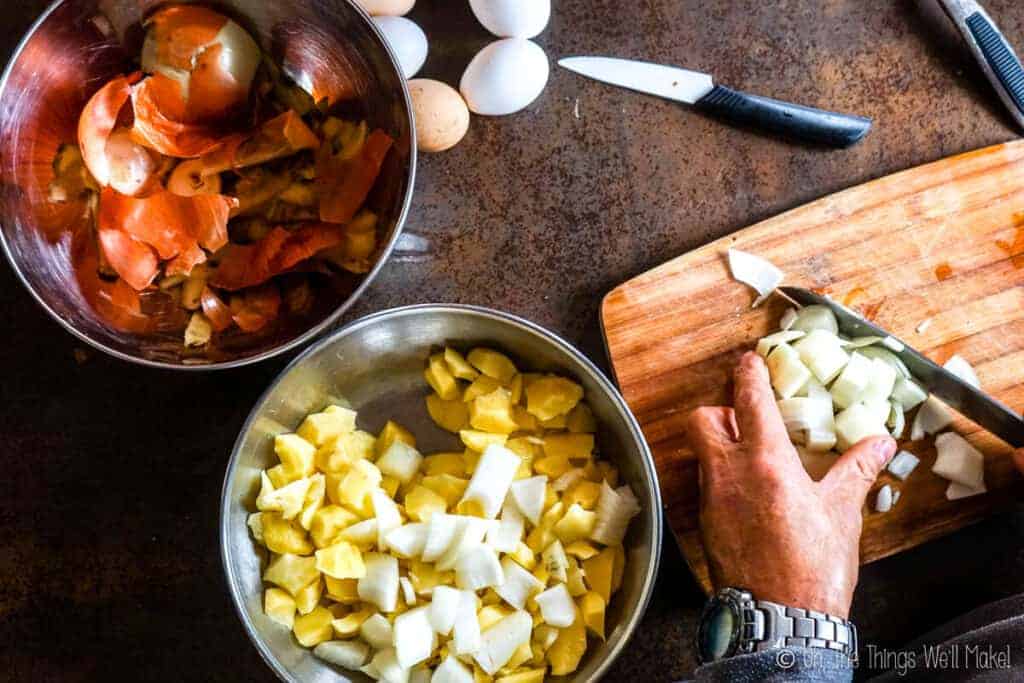
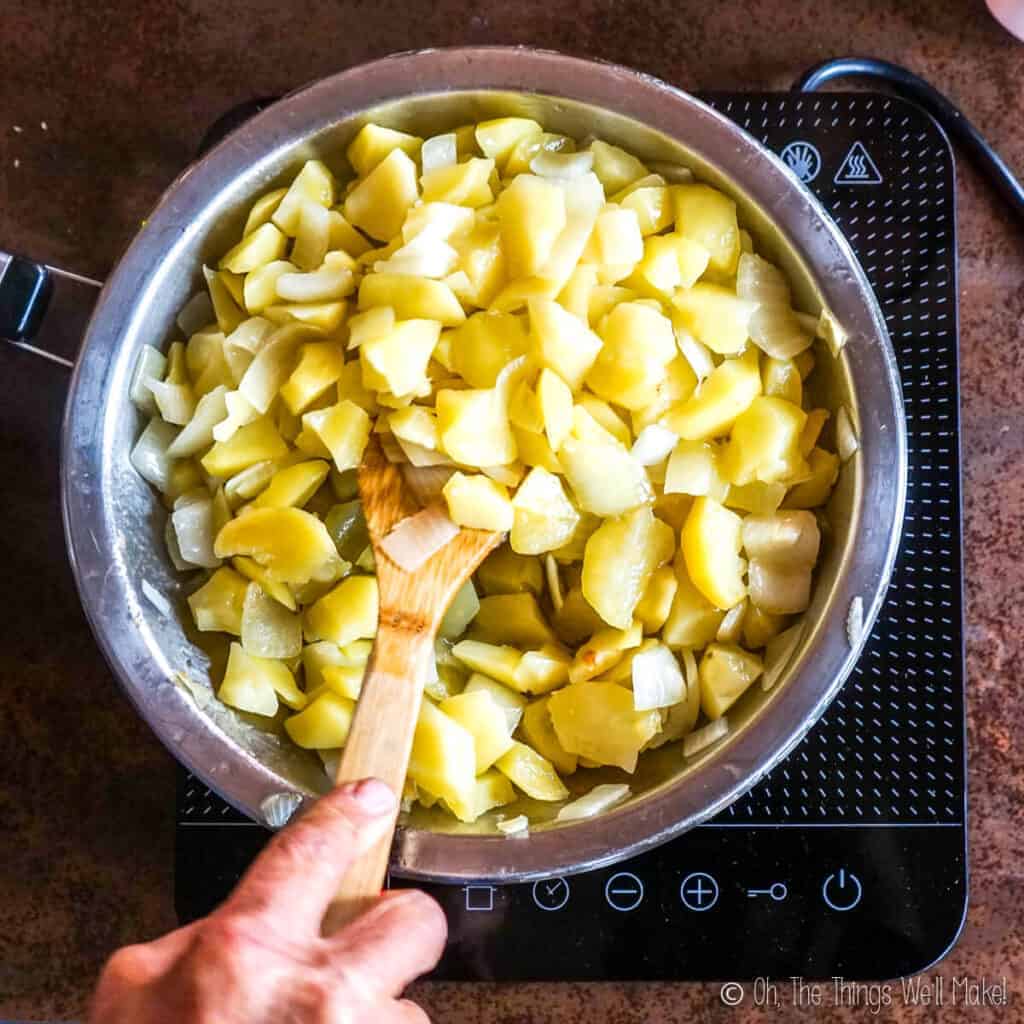
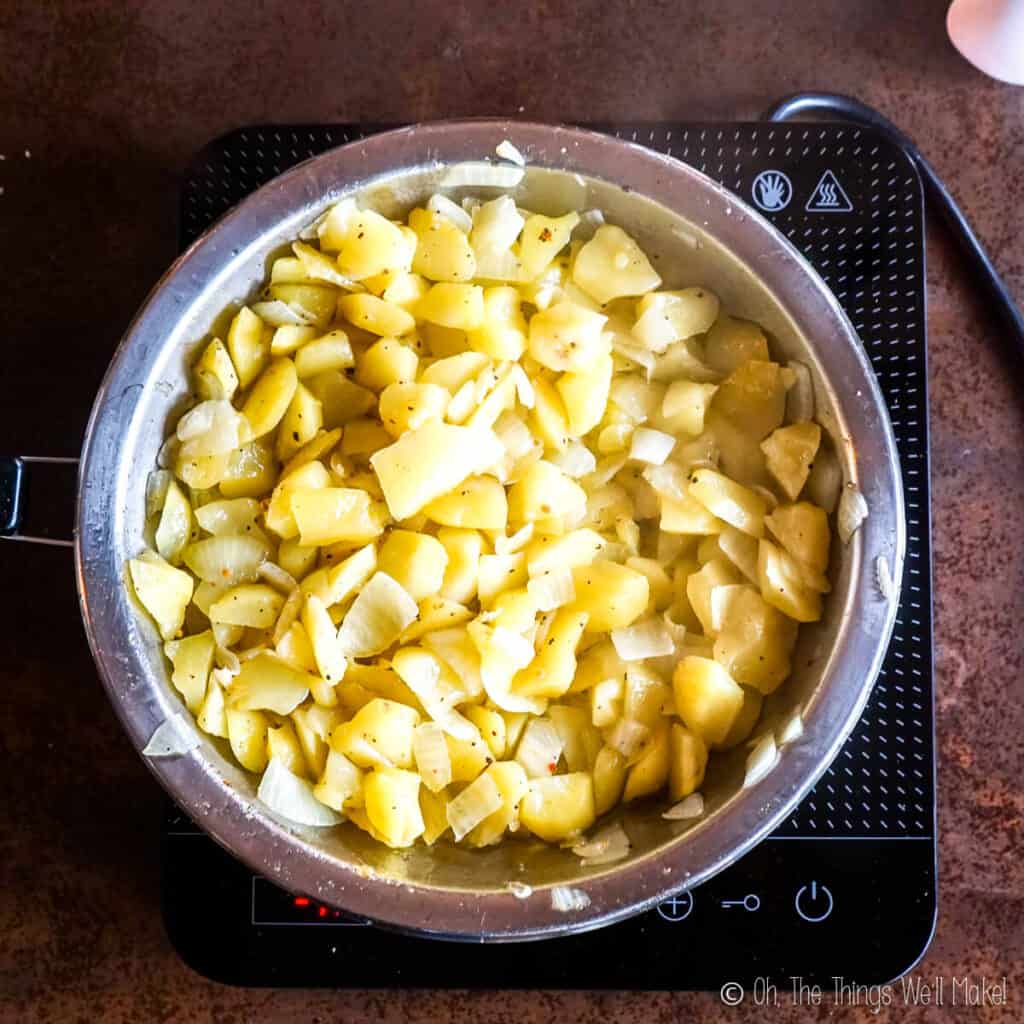
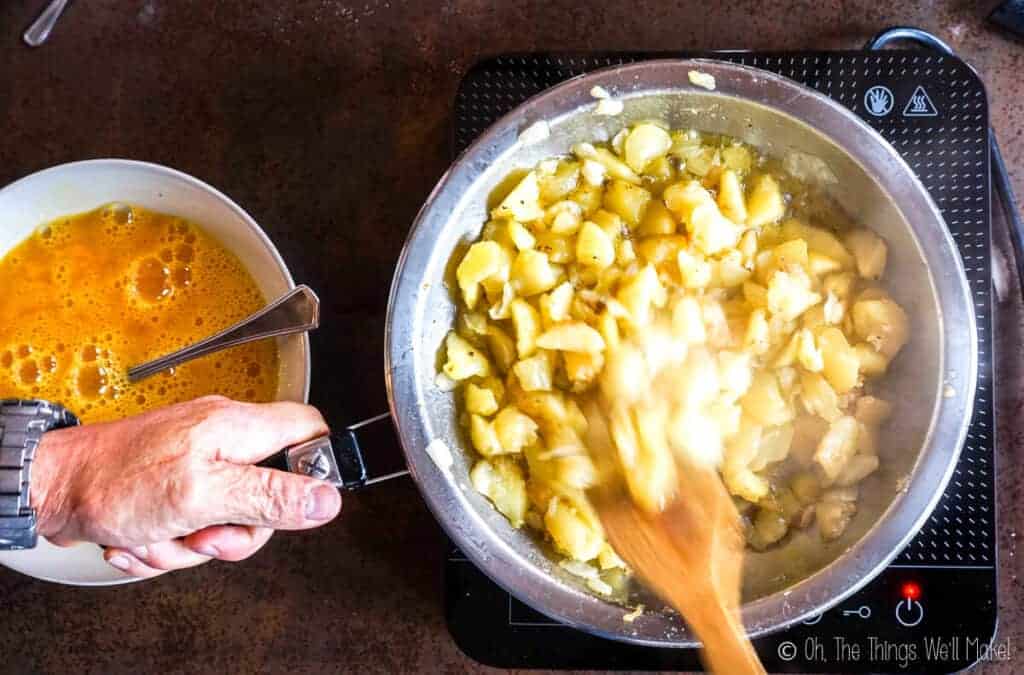
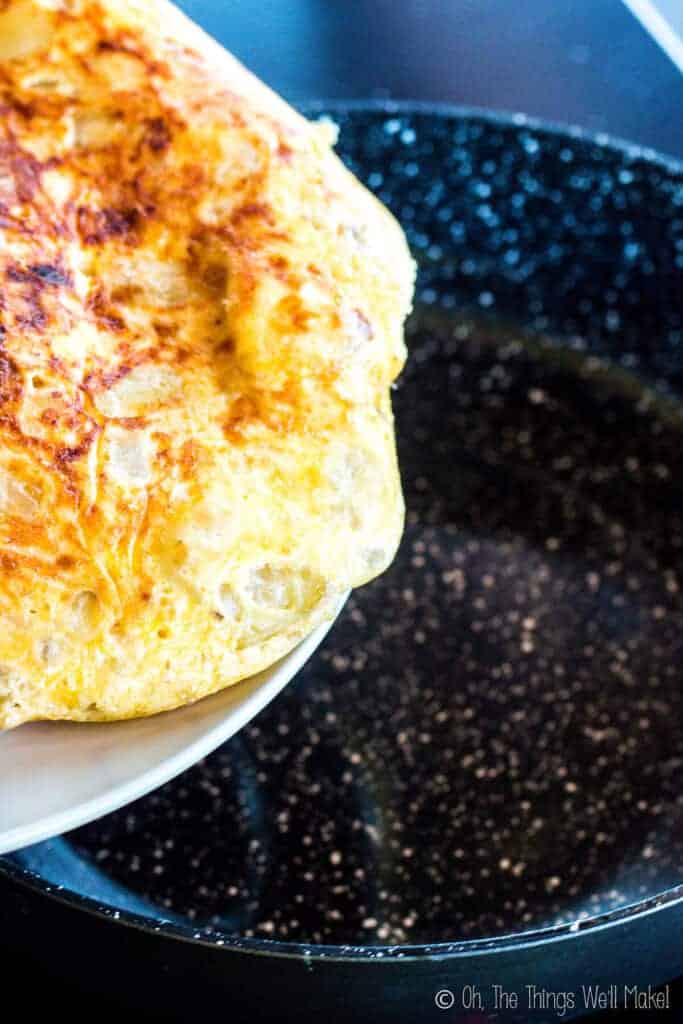
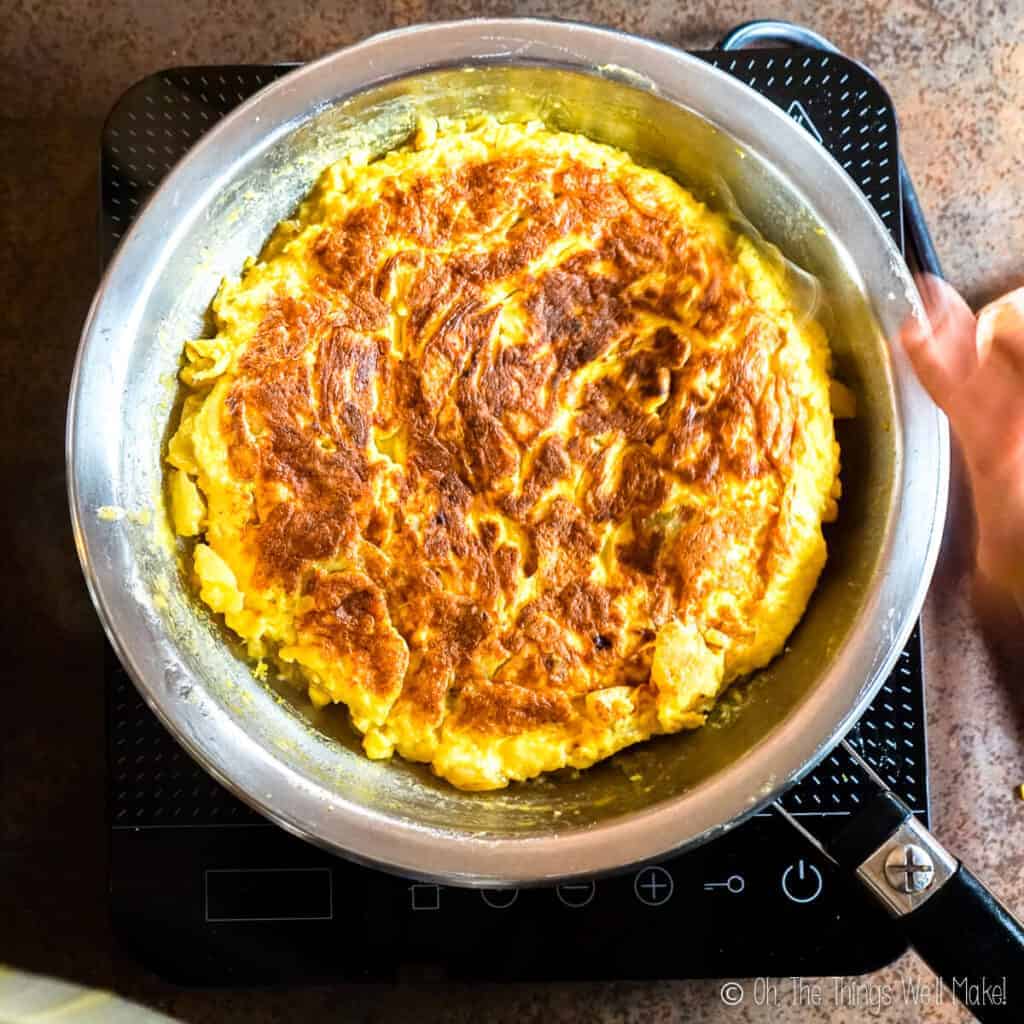
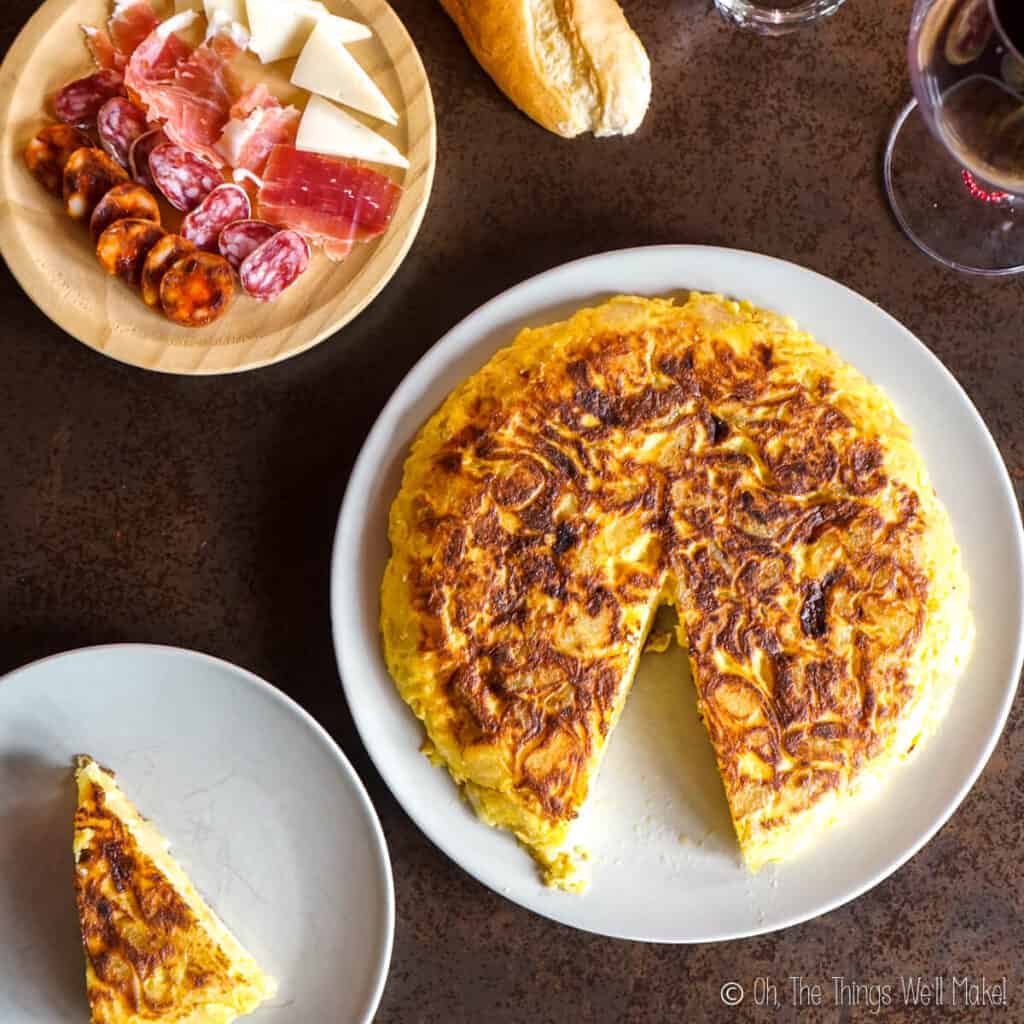
 Coconut Date Balls (Or Bites)
Coconut Date Balls (Or Bites)
Jeff Morris
I’ve been a student of Spanish tortillas for years, and this is by far the best and most comprehensive overview I’ve found. I love this page!!! I will have to check out the rest of your site. I’m excited to compare your homemade chorizo to my own 😉
I have one comment that could help beginners. After making many dozens of these, I continue to feel nervous to flip the half-done tortilla onto the plate for cooking the other side. The reason I’m nervous is I’ve had a mess once or twice. The “flip” is something like an Olympic event. You need the right sized plate, and you need to plan like you’re about to dismount the balance beam. Worst case is raw egg sauce everywhere and a burnt hand. I’ve learned to do it over a nice empty part of a counter in case there is some spill (for easy cleaning later).
And I also have one variation to offer. After dicing my potatoes, I parboil them (cook in water until partially done) before adding to the frying onions (which I like to thinly slice).
My favorite is the leftover the next day, cold. It’s always much better than the hot one the day I make it.
Thank you for sharing your Spanish cooking knowledge!!! Together with Japanese, this is one of my two favorite cuisines.
Tracy Ariza, DDS
Hi Jeff,
Thanks so much for your comment and your great tips. I may add some of those ideas next time I update this post. (I like to periodically update all of my posts.)
I’ve actually been considering making a blog dedicated to Spanish food and recipes and have already bought the domain foodtapasandwine.com. I haven’t gotten around to setting everything up yet, though. This site has attracted mostly healthy living people, and there are times when I’d like to share a less healthy croquetas recipe or something like that!
I know what you mean about the plate size- and like the idea of flipping over an empty counter. Ha! I’m a bit clumsy and have had issues flipping too, especially with large tortillas.
I’ve always used plates that were quite flat and larger than the pan, but I have been talking with a chef here that actually prefers a smaller plate that fits just inside the pan for flipping. I hadn’t even considered that option, but it seems to work really well for him!
And, yes, it’s great as lefotvers! Definitely!!
Angie
Excellent tutorial! I like to make my tortilla in my cast iron Dutch oven. I’ve done stove top finished and oven finished. In the states we can get “Simply Potatoes” in the refrigerator section of the store which are frying potatoes (with and without onions) that are already cooked. They work well if time is a factor.
Tracy Ariza, DDS
Great tips! Thanks, Angie!